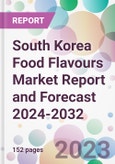Market Outlook
According to the report the South Korea food flavours market grew significantly in 2023. Aided by the evolving Korean culinary landscape and a rising inclination towards innovative gastronomic experiences, the market is projected to further grow at a CAGR of 4.1% between 2024 and 2032 to reach a value of about USD 1171.9 million by 2032.Food flavours, whether natural or artificial, play a pivotal role in enhancing the sensory experience of food products. They are essential components that determine the aroma and taste of numerous processed foods, confectionery items, beverages, and even certain traditional dishes. In the context of South Korea, a nation known for its rich culinary heritage and rapid modernisation, food flavours have seamlessly integrated into the dynamic food and beverage industry.
A significant catalyst for the South Korean food flavours market growth is the country’s passionate food culture. South Korea is renowned for its traditional dishes like kimchi, bulgogi, and bibimbap. However, as urbanisation intensifies and global influences penetrate deeper into Korean society, there's been an evident shift towards fusion cuisines and innovative flavour profiles. This evolution is driving food manufacturers to incorporate a plethora of flavouring agents to cater to the diversified and sophisticated palate of the Korean consumer.
Additionally, the country's burgeoning convenience food sector and the popularity of snacks and beverages with distinct flavour twists further bolster the South Korea food flavours market demand. Flavours like honey butter, spicy chilli, and even exotic fruit combinations have witnessed soaring popularity in recent years. The success of such products underscores the importance of flavour innovation in capturing market share and consumer loyalty.
Beyond traditional application areas, the food flavours market in South Korea also finds promising growth avenues in the burgeoning health and wellness sector. As health-consciousness rises among Koreans, there's a surge in demand for natural and organic flavouring agents that align with the clean-label movement and the general shift towards healthier food options.
According to the South Korea food flavours market analysis, the influence of K-pop and K-dramas has magnified the global reach of Korean cuisine. This international spotlight has led to a demand for authentic Korean flavours, as well as a counter-demand within South Korea for global flavours, as locals seek to indulge in international gourmet experiences at home.
Market Segmentation
The market can be divided based on type, origin, and application.Market Breakup by Type
- Chocolate and Brown
- Vanilla
- Fruit and Nut
- Spice and Savoury
- Others
Market Breakup by Origin
- Nature-Identical
- Natural
- Artificial/Synthetic
Market Breakup by Application
- Beverages
- Juices and Juice Concentrates
- Functional Drinks
- Carbonated Soft Drinks
- Others
- Food
- Frozen Products
- Dairy Products
- Bakery and Confectionery Products
- Meat Products
- Others
Competitive Landscape
The report looks into the market shares, plant turnarounds, capacities, investments, and mergers and acquisitions, among other major developments, of the leading companies operating in the South Korea food flavours market. Some of the major players explored in the report are as follows:- Symrise AG
- Robertet Korea
- Kerry Group plc.
- Huabao International Holdings Limited
- Givaudan International SA
- International Flavors & Fragrances Inc.
- Firmenich SA.
- Others
Table of Contents
Companies Mentioned
- Symrise AG
- Robertet Korea
- Kerry Group plc.
- Huabao International Holdings Limited
- Givaudan International SA
- International Flavors & Fragrances Inc.
- Firmenich SA.
Methodology

LOADING...








